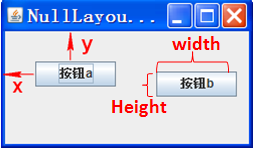转:三十三、Java图形化界面设计——布局管理器之null布局(空布局)——即SWT中的绝对布局
一般容器都有默认布局方式,但是有时候需要精确指定各个组建的大小和位置,就需要用到空布局。
操作方法:
1) 首先利用setLayout(null)语句将容器的布局设置为null布局(空布局)。
2) 再调用组件的setBounds(int x, int y, int width,int height)方法设置组件在容器中的大小和位置,单位均为像素。
x为控件左边缘离窗体左边缘的距离
y为控件上边缘离窗体上边缘的距离
width为控件宽度
height为控件高度
实例:使用空布局精确定位组件的位置
// NullLayoutDemo.java
import java.awt.*;
import javax.swing.*;
public class NullLayoutDemo{
JFrame fr;
JButton a,b;
NullLayoutDemo() {
fr = new JFrame();
fr.setBounds(100,100,250,150);
//设置窗体为空布局
fr.setLayout(null);
a=new JButton("按钮a");
b=new JButton("按钮b");
fr.getContentPane().add(a);
//设置按钮a的精确位置
a.setBounds(30,30,80,25);
fr.getContentPane().add(b);
b.setBounds(150,40,80,25);
fr.setTitle("NullLayoutDemo");
fr.setVisible(true);
fr.setDefaultCloseOperation(JFrame.EXIT_ON_CLOSE);
fr.setLocationRelativeTo(null); //让窗体居中显示
}
public static void main(String args[]){
new NullLayoutDemo();
}
}
程序运行结果如下:

who:whaozl
QQ:1057674944
email:whaozl@163.com
blog:http://www.cnblogs.com/whaozl
note:原创博客请尊重版权,转载必须得到本人同意


